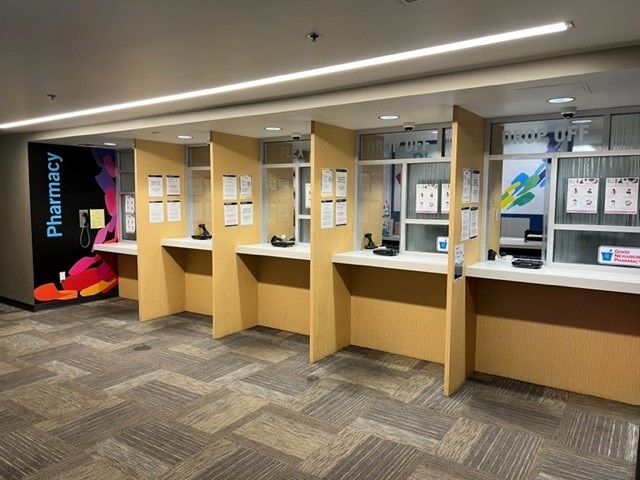There are two main reasons Greg Bowles, Ph.T, associate director of pharmacy at the Los Angeles LGBT Center, sleeps better at night, having the scripClip™ system: “time management and patient safety.” This case study illustrates how that good night’s rest came to be…
The Opportunity
Bowles’ 2,400-square-foot pharmacy in Hollywood fills anywhere from 900 to 1,200 prescriptions daily for patients – 4,500 of whom come in at least every 20-23 days. Established in 1969, the LA LGBT Center has grown to be a widely recognized federally qualified health center (FQHC) that advocates for historically underserved individuals in the LGBT community. The health clinic offers a variety of services, including HIV care, primary care, gender health and mental health services. As a vital arm of the clinic, the pharmacy and its staff are well integrated in the patient care system, delivering high-touch clinical services during the prescription dispensing process. With five pickup windows, they have a minimum of eight frontline pharmacists on any given day and employ 62 people, including on-call staff, clinical pharmacists, technicians, inventory coordinators, and a team dedicated to financial assistance programs and prior authorizations.
Years ago, Bowles recognized the need for an automated will-call system to streamline prescription pickup for both staff and customers.
“I think back to the days before we had a light-up bag system – manually searching through racks and racks of will-call orders,” Bowles recalled. “Each patient would take about five minutes. Imagine if you can’t find an order, then it’s a chaotic scramble looking around a 2400-square-foot pharmacy. It’s ultimately taking time away from us to provide the best patient care experience.”
It didn’t take much for him to convince the organization to invest in new technology to help alleviate the burden. “[Leadership] is super-supportive of pharmacy operations and, once you dialogue about the safety measures [and] time savings, it’s a no-brainer,” Bowles explained.

The Solution
With input from their pharmacy management system vendor, Bowles and team settled on a hanging-bag will-call automation system. But one day, early in the COVID-19 pandemic, that system failed and, because the company had gone out of business, the LA LGBT Center pharmacy was left in a lurch.
“It’s one of those things, similar to when we got robotics in our pharmacy: everybody kind of fought it [at first], but once they have the technology, they can’t imagine doing their jobs without it,” Bowles said.
Fortunately, it didn’t take long for scripClip to come to the rescue. InterLink AI helped migrate 1,200 prescriptions to the new system and get the team up and running in a week’s time.
“Any time you’re introducing a new technology, as an ops guy, you just kind of go, ‘this is gonna be awful,’” he said. “It wasn’t. From beginning to end – the training, the learning curve with the staff, remote onboarding – it was one of the easiest processes I have ever gone through. … Flawless.”
The Payoff
The 10 minutes per customer it used to take? Now, Bowles’ team retrieves prescriptions “within seconds.”
He touts how scripClip technology helps eliminate the chance of making an error by grabbing the wrong prescription for the wrong patient, or letting a customer leave the pharmacy without all of their prescriptions.
“scripClip solves all that: You’re going to get every component of their order when they’re there to pick it up.”
It also saves the pharmacy team hours on return to stock. Think about having to manually search through a large will-call area where orders are maintained for 14 days, to manually search for and doublecheck prescriptions. “No. Just, no,” Bowles said with a laugh.
Close-up on the COVID-19 Impact
The onset of COVID disrupted all operations at LA LGBT Center, but the pharmacy never closed its doors.
“January 2021 [during the COVID-19 surge] was a perfect example of when we’re stretched on staffing. … We were anywhere from 20 to 40% short on staff every single day,” Bowles recalled.
He saw big shifts in the percentage of deliveries and pharmacy foot-traffic. “We generally have [a maximum of] 10 people in line during our busy times, but there were times where the line was through the lobby, out the front doors and down the ramp. Extrapolate that time out: if you’re spending five minutes looking for an order, times 50 people in line…
“The thought of manually searching for a [patient’s prescription] bag – it just makes me sick.
“scripClip saved [us]. … I don’t know how pharmacies do anything without it.”
“The biggest thing I would share is that if people are on the fence about whether or not they should invest in [scripClip], they absolutely should,” Bowles said. “Don’t wait.”
“Come on down [to Hollywood],” he invited. “I’m more than happy to demonstrate how it works.”
